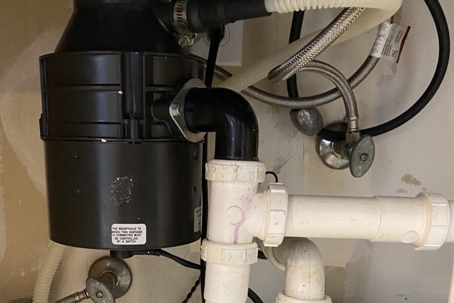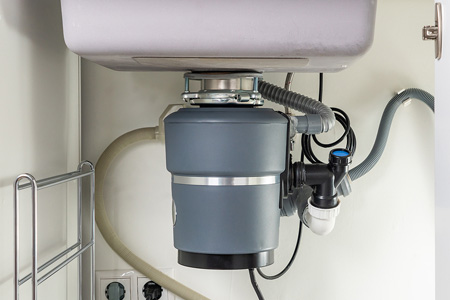Easy-to-Follow Instructions for Repairing a Leaky Waste Disposal
Easy-to-Follow Instructions for Repairing a Leaky Waste Disposal
Blog Article
What are your thoughts and feelings on Why Is ?

Waste disposal unit are necessary kitchen area appliances that aid in throwing away food waste efficiently. However, a dripping garbage disposal can be a frustrating and unpleasant problem to manage. Thankfully, several leaks can be dealt with easily with a few easy steps. In this article, we will talk about exactly how to take care of a leaking garbage disposal successfully.
Intro
Garbage disposals are set up under cooking area sinks and are designed to shred food waste into smaller pieces, enabling it to travel through the plumbing system easily. While these devices are typically trusted, leaks can occur over time due to damage, loosened links, or damages to the device.
Typical Root Causes Of Leakages in Rubbish Disposals
Worn Seals and Gaskets
Seals and gaskets play a critical duty in stopping water from leaking out of the garbage disposal. Gradually, these elements can weaken, leading to leakages around the disposal system.
Loose Connections
The links in between the garbage disposal and the pipes system can become loosened in time, causing water to leakage out during procedure.
Fractures or Holes in the Disposal System
Physical damage to the waste disposal unit, such as cracks or openings in the real estate, can also cause leaks.
Determining the Source of the Leak
Prior to attempting to take care of a leaking waste disposal unit, it is necessary to recognize the source of the leak. This can commonly be done via visual evaluation or by performing basic tests.
Visual Inspection
Inspect the waste disposal unit system carefully for any type of signs of water leakage. Pay close attention to areas around seals, gaskets, and connection points.
Checking for Leakages
One means to examine for leakages is by running water via the disposal device and looking for any kind of visible signs of leakage.
Devices and Products Needed for Dealing With a Dripping Waste Disposal Unit
Prior to starting the repair service process, gather the necessary tools and materials, consisting of a screwdriver, flexible wrench, plumbing technician's putty, replacement seals or gaskets, and epoxy or patching material for fixing fractures or holes.
Step-by-Step Overview to Taking Care Of a Leaking Waste Disposal Unit
Switch off the Power
Before attempting any type of repair work, make certain that the power to the garbage disposal device is shut off to prevent the danger of electrical shock.
Locate the Leak
Recognize the exact place of the leakage and identify the reason.
Tighten Connections
Make use of a wrench to tighten up any loosened links in between the disposal unit and the plumbing system.
Change Seals or Gaskets
If the leakage is due to worn seals or gaskets, eliminate the old parts and change them with new ones.
Patching Cracks or Holes
For fractures or holes in the disposal system, usage epoxy or an ideal patching product to secure the broken location.
Testing the Garbage Disposal After Fixing
When the repair is total, examine the garbage disposal by running water with it to make sure that the leak has actually been dealt with.
Preventive Upkeep Tips to Prevent Future Leakages
To stop future leaks, it is vital to perform normal upkeep on your waste disposal unit. This includes keeping it clean, preventing placing non-food products or difficult items down the disposal, and occasionally looking for leakages or other issues.
Conclusion
In conclusion, repairing a leaking waste disposal unit is a reasonably uncomplicated procedure that can be completed with fundamental tools and materials. By adhering to the steps described in this article and exercising precautionary maintenance, you can maintain your waste disposal unit in good working condition and avoid pricey repair work in the future.
What to Do About a Leaking Garbage Disposal
A leaking garbage disposal often goes unnoticed until you confront a sopping cabinet, a foul-smelling puddle, or an audible drip-drip-drip from the unit. The fix can be frustrating, too, because the leak can stem from a number of components in the system. Fortunately, with a little sleuthing, you can zero in on the leak and—depending on the exact location—stop the icky oozing and repair the component that caused it. Worst case scenario, if it turns out that the garbage disposal must be replaced, installing a new one is a reasonable do-it-yourself task for those with basic plumbing skills. Read on to keep the cash you’d otherwise hand over to a pro.
Prepare to find the leak
Prior to testing the garbage disposal for leaks, unplug it at the wall outlet and turn off the power from the breaker box to prevent electrical shock. Then insert a watertight sink stopper into your sink drain and wipe the unit dry with a clean cloth. In any handy container, mix a few drops of food coloring into a few cups of water, and pour the dyed water onto the sink stopper to help you locate the leak.
Investigate the source
the top, where the disposal meets the sink drain the side, where the dishwasher hose or main drain pipe connects to the disposal or the bottom of the unit Inspect each of these locations while gliding a light-colored rag over the unit; the dyed water will readily show on the rag and reveal the location of the leak. If a leak isn’t immediately apparent, remove the sink stopper and pour a few more cups of dyed water down the sink drain, then check for leaks again. Leaks near the top of the unit are more likely to show themselves while the sink is plugged, while side and bottom leaks are more noticeable while the sink is unplugged.
The metal sink flange that sits directly inside the sink drain is typically sealed around the top with plumber’s putty (a clay-like sealant) and then secured from under the sink with bolts. If the plumber’s putty deteriorates, or the bolts loosen, the flange can no longer form a watertight seal between the sink drain and the disposal—which could cause a leak at the top of the unit.
To reseal the leaky flange, you must first detach the garbage disposal. Start by loosening the screws securing the main drain pipe to the disposal, then loosen the screws in the metal clamp securing the dishwasher hose to the disposal and detach the drain pipe and dishwasher hose from the disposal. Loosen the screws in the mounting ring that connects the disposal to the metal mounting assembly beneath the sink, then pull down the disposal and carefully set it on a clean, dry surface. Loosen the bolts in the mounting assembly with a wrench, then pull down the mounting assembly and set it near the disposal.

We had been shown that report on Tips on Fixing a Leaking Garbage Disposal from a friend on a different domain. For those who appreciated our blog entry if you please remember to share it. We thank you for reading our article about How to fix a pretty consistent leak from my garbage disposal.
Call Today Report this page